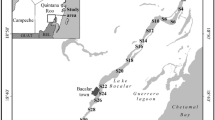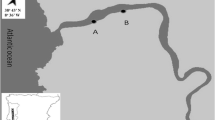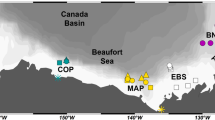Abstract
In the benthos of lakes, habitat size and structure as well as oxygen or resource availability can affect species distribution at local scales. By contrast, there is little knowledge about the mechanisms that determine the structure of benthic communities at larger scales. Here, we compiled data from the literature (23 studies monitoring 129 sites from 75 lakes located in central and northern Europe) to search for broad patterns in abundance, biomass, and community structure linked to lake trophic state (oligo-, meso-, or eutrophic), habitat features (hard vs. soft substrates), and water depth (littoral vs. profundal). The benthic meiofauna appeared much more abundant in the periphyton, and biomass was lower in oligotrophic lakes. Focusing on free-living nematodes, community structure differed markedly in hard vs soft substrates. Further, nematodes were especially dominant in profundal zones, where their diversity was significantly influenced by lake trophic state. In profundal zones of eutrophic lakes, nematode assemblages were less diverse and dominated by larger, mostly omnivorous or predacious taxa.






Similar content being viewed by others
References
Anderson, M. J., 2001. A new method for non-parametric multivariate analysis of variance. Austral Ecology 26: 32–46.
Anderson, M. J., 2006. Distance-based tests for homogeneity of multivariate dispersions. Biometrics 62: 245–253.
Barnett, A. & B. E. Beisner, 2007. Zooplankton biodiversity and lake trophic state: explanations invoking resource abundance and distribution. Ecology 88: 1675–1686.
Bergtold, M. & W. Traunspurger, 2004. The benthic community in the profundal of Lake Brunnsee: seasonal and spatial patterns. Archiv für Hydrobiologie 160: 527–554.
Bergtold, M. & W. Traunspurger, 2005. Benthic production by micro-, meio-, and macrobenthos in the profundal zone of an oligotrophic lake. Journal of the North American Benthological Society 24: 321–329.
Bogut, I., J. Vidakovic, D. Cerba & G. Palijan, 2009. Epiphytic meiofauna in stands of different submerged macrophytes. Ekoloji Dergisi 18: 1–9.
Boulton, A., C. Hakenkamp, M. Palmer & D. Strayer, 2002. Freshwater meiofauna and surface water-sediment linkages: a conceptual framework for cross-system comparisons. In Rundle, S. D., A. L. Robertson & J. M. Schmid-Araya (eds), Freshwater Meiofauna: Biology and Ecology. Backhuys Publishers, Leiden: 241–259.
Brodersen, K. P., P. C. Dall & C. Lindegaard, 1998. The fauna in the upper stony littoral of Danish lakes: macroinvertebrates as trophic indicators. Freshwater Biology 39: 577–592.
Cáceres, M. D. & P. Legendre, 2009. Associations between species and groups of sites: indices and statistical inference. Ecology 90: 3566–3574.
Croll, N. A. & A. Zullini, 1972. Observations on the bionomics of the freshwater nematode Chromadorina bioculata. Journal of Nematology 4: 256–260.
Dodson, S., 1992. Predicting crustacean zooplankton species richness. Limnology and Oceanography 37: 848–856.
Estifanos, T. K., W. Traunspurger & L. Peters, 2013. Selective feeding in nematodes: a stable isotope analysis of bacteria and algae as food sources for free-living nematodes. Nematology 15: 1–13.
Eyualem-Abebe, I. Andrássy & W. Traunspurger, 2006. Freshwater Nematodes: Ecology and Taxonomy. CABI publishing, Wallingford.
Gansfort, B., J. Uthoff & W. Traunspurger, 2018. Interactions among competing nematode species affect population growth rates. Oecologia 187: 75–84.
Gaudes, A., S. Sabater, E. Vilalta & I. Muñoz, 2006. The nematode community in cyanobacterial biofilms in the river Llobregat, Spain. Nematology 8: 909–919.
Giere, O., 2009. Meiobenthology: The Microscopic Motile Fauna of Aquatic Sediments. Springer - Verlag, Berlin.
Goedkoop, W. & R. K. Johnson, 1996. Pelagic-benthic coupling: profundal benthic community response to spring diatom deposition in mesotrophic Lake Erken. Limnology and Oceanography 41: 636–647.
Harzing, A.-W., 2007. Publish or perish. Tarma Software Research Pty Limited.
Heip, C., M. Vincx & G. Vranken, 1985. The Ecology of Marine Nematodes. Aberdeen University Press, London.
Hohberg, K. & W. Traunspurger, 2009. Foraging theory and partial consumption in a tardigrade-nematode system. Behavioral Ecology 20: 884–890.
Holopainen, I. J., & L. Paasivirta, 1977. Abundance and biomass of the meiozoobenthos in the oligotrophic and mesohumic lake Pääjärvi, southern Finland. In Annales Zoologici Fennici: 124–134.
Jeppesen, E., J. Peder Jensen, M. SØndergaard, T. Lauridsen & F. Landkildehus, 2000. Trophic structure, species richness and biodiversity in Danish lakes: changes along a phosphorus gradient. Freshwater Biology 45: 201–218.
Kathol, M., H. Fischer & M. Weitere, 2011. Contribution of biofilm-dwelling consumers to pelagic–benthic coupling in a large river. Freshwater Biology 56: 1160–1172.
Kazemi-Dinan, A., F. Schroeder, L. Peters, N. Majdi & W. Traunspurger, 2014. The effect of trophic state and depth on periphytic nematode communities in lakes. Limnologica 44: 49–57.
Kurashov, E. A., 2002. The role of meiobenthos in lake ecosystems. Aquatic Ecology 36: 447–463.
Kreuzinger-Janik, B., F. Schroeder, N. Majdi & W. Traunspurger, 2015. Depth-related effects on a meiofaunal community dwelling in the periphyton of a mesotrophic lake. PLoS One 10: e0137793.
Majdi, N. & W. Traunspurger, 2015. Free-living nematodes in the freshwater food web: a review. Journal of Nematology 47: 28–44.
Majdi, N., B. Mialet, S. Boyer, M. Tackx, J. Leflaive, S. Boulêtreau, L. Ten-Hage, F. Julien, R. Fernandez & E. Buffan-Dubau, 2012a. The relationship between epilithic biofilm stability and its associated meiofauna under two patterns of flood disturbance. Freshwater Science 31: 38–50.
Majdi, N., M. Tackx & E. Buffan-Dubau, 2012b. Trophic positionning and microphytobenthic carbon uptake of biofilm-dwelling meiofauna in a temperate river. Freshwater Biology 57: 1180–1190.
Majdi, N., M. Tackx, W. Traunspurger & E. Buffan-Dubau, 2012c. Feeding of biofilm-dwelling nematodes examined using HPLC-analysis of gut pigment contents. Hydrobiologia 680: 219–232.
Majdi, N., I. Threis & W. Traunspurger, 2017. It’s the little things that count: meiofaunal density and production in the sediment of two headwater streams: Meiofauna in Streams. Limnology and Oceanography 62: 151–163.
Meschkat, A., 1934. Der Bewuchs in der Röhrichten des Plattensees. Archiv für Hydrobiologie 27: 436–517.
Michiels, I. C. & W. Traunspurger, 2003. Maintenance of biodiversity through predation in freshwater nematodes? Nematology Monographs and Perspectives 2: 1–15.
Michiels, I. C. & W. Traunspurger, 2004. A three year study of seasonal dynamics of a zoobenthos community in a eutrophic lake. Nematology 6: 655–669.
Michiels, I. C. & W. Traunspurger, 2005. Seasonal variation of biodiversity and assemblage structure in freshwater nematodes. Archiv für Hydrobiologie 163: 183–194.
Moens, T., W. Traunspurger & M. Bergtold, 2006. Feeding ecology of free-living benthic nematodes. In Eyualem-Abebe, W. Traunspurger & I. Andrássy (eds), Freshwater Nematodes: Ecology and Taxonomy. CABI Publishing, Wallingford: 105–131.
Nalepa, T. F. & M. A. Quigley, 1985. Distribution of epibenthic microcrustaceans in nearshore Lake Michigan. Freshwater Invertebrate Biology 4: 53–63.
Neury-Ormanni, J., J. Vedrenne & S. Morin, 2016. Who eats who in biofilms? Exploring the drivers of microalgal and micro-meiofaunal abundance. Botany Letters 163: 83–92.
Pennak, R. W., 1988. Ecology of the Freshwater Meiofauna. Smithsonian Institute, Washington, DC.
Peters, L. & W. Traunspurger, 2005. Species distribution of free-living nematodes and other meiofauna in littoral periphyton communities of lakes. Nematology 7: 267–280.
Peters, L., M. A. Wetzel & W. Traunspurger, 2007. Epilithic communities in a lake littoral zone: the role of water-column transport and habitat development for dispersal and colonization of meiofauna. Journal of the North American Benthological Society 26: 232–243.
Pimm, S. L., 2002. Food Webs. University of Chicago Press, Chicago.
Poikane, S., R. K. Johnson, L. Sandin, A. K. Schartau, A. G. Solimini, G. Urbanič, K. Arbačiauskas, J. Aroviita, W. Gabriels, O. Miler, M. T. Pusch, H. Timm & J. Böhmer, 2016. Benthic macroinvertebrates in lake ecological assessment: a review of methods, intercalibration and practical recommendations. Science of the Total Environment 543: 123–134.
R Development Core Team, 2018. R: A Language and Environment for Statistical Computing. R Foundation for Statistical Computing, Vienna.
Ricci, C. & M. Balsamo, 2000. The biology and ecology of lotic rotifers and gastrotrichs. Freshwater Biology 44: 15–28.
Ristau, K. & W. Traunspurger, 2011. Relation between nematode communities and trophic state in southern Swedish lakes. Hydrobiologia 663: 121–133.
Ristau, K., M. Faupel & W. Traunspurger, 2013. Effects of nutrient enrichment on the trophic structure and species composition of freshwater nematodes-a microcosm study. Freshwater Science 32: 155–168.
Rundle, S. D., A. L. Robertson & J. M. Schmid-Araya, 2002. Freshwater meiofauna: Biology and ecology. Backhuys, Leiden.
Särkkä, J., 1993. Diversity of meiofauna in the lacustrine profundal zone—bathymetric differences and influence of environmental-factors. Aquatic Sciences 55: 197–205.
Särkkä, J., 1994. Lacustrine, profundal meiobenthic oligochaetes as indicators of trophy and organic loading. In Aquatic Oligochaete Biology V. Springer: 231–241.
Särkkä, J., 1995. Profundal meiofauna in two large lakes: influence of pollution and bathymetric differences. Archiv für Hydrobiologie 132: 453–493.
Särkkä, J., 1996. Meiofauna ratios as environmental indicators in the profundal depths of large lakes. Environmental Monitoring and Assessment 42: 229–242.
Särkkä, J. & L. Paasivirta, 1972. Vertical distribution and abundance of the macro-and meiofauna in the profundal sediments of Lake Päijänne, Finland. Annales Zoologici Fennici 9: 1–9.
Schmid-Araya, J. M., A. G. Hildrew, A. Robertson, P. E. Schmid & J. Winterbottom, 2002. The importance of meiofauna in food webs: evidence from an acid stream. Ecology 83: 1271–1285.
Schroeder, F., L. Peters & W. Traunspurger, 2012a. Temporal variations in epilithic nematode assemblages in lakes of different productivities. Fundamental and Applied Limnology 181: 143–157.
Schroeder, F., W. Traunspurger, K. Pettersson & L. Peters, 2012b. Temporal changes in periphytic meiofauna in lakes of different trophic states. Journal of Limnology 71: 216–227.
Silver, P., M. A. Palmer, C. M. Swan & D. Wooster, 2002. The small scale ecology of freshwater meiofauna. In Rundle, S. D., A. L. Robertson & J. M. Schmid-Araya (eds), Freshwater Meiofauna: Biology and Ecology. Backhuys Publishers, Leiden: 217–239.
Strayer, D. L., 1985. The benthic micrometazoans of Mirror lake. New Hampshire. Archiv für Hydrobiologie Suppl. 72: 287–426.
Tinson, S. & J. Laybourn-Parry, 1986. The distribution and abundance of benthic cyclopoid copepods in Esthwaite Water, Cumbria. Hydrobiologia 131: 225–234.
Traunspurger, W., 1996a. Distribution of benthic nematodes in the littoral of an oligotrophic lake (Konigssee, National Park Berchtesgaden, FRG). Archiv für Hydrobiologie 135: 393–412.
Traunspurger, W., 1996b. Distribution of benthic nematodes in the littoriprofundal and profundal of an oligotrophic lake (Konigssee, National Park Berchtesgaden, FRG). Archiv für Hydrobiologie 135: 557–575.
Traunspurger, W., 1996c. Autecology of Monhystera paludicola De Man, 1880—seasonal, bathymetric and vertical distribution of a free-living nematode in an oligotrophic lake. Internationale Revue der gesamten Hydrobiologie 81: 201–213.
Traunspurger, W., 1997a. Bathymetric, seasonal and vertical distribution of feeding-types of nematodes in an oligotrophic lake. Vie et Milieu 47: 1–7.
Traunspurger, W., 1997b. Distribution, seasonal occurence, and vertical patterns of Tobrilus gracilis and Tobrilus medius (Nematoda). Nematologica 43: 59–81.
Traunspurger, W., 2000. The biology and ecology of lotic nematodes. Freshwater Biology 44: 29–45.
Traunspurger, W., 2002. Nematoda. In Rundle, S. D., A. L. Robertson & J. M. Schmid-Araya (eds), Freshwater meiofauna: biology and ecology. Backhuys Publishers, Leiden: 63–104.
Traunspurger, W., M. Bergtold, A. Ettemeyer & W. Goedkoop, 2006. Effects of copepods and chironomids on the abundance and vertical distribution of nematodes in a freshwater sediment. Journal of Freshwater Ecology 21: 81–90.
Traunspurger, W., S. Höss, A. Witthöft-Mühlmann, M. Wessels & H. Güde, 2012. Meiobenthic community patterns of oligotrophic and deep Lake Constance in relation to water depth and nutrients. Fundamental and Applied Limnology 180: 233–248.
Vadeboncoeur, Y. & A. D. Steinman, 2002. Periphyton function in lake ecosystems. The Scientific World Journal 2: 1449–1468.
Vadeboncoeur, Y., P. B. McIntyre & M. J. Vander Zanden, 2011. Borders of biodiversity: life at the edge of the world’s large lakes. BioScience 61: 526–537.
Weber, S. & W. Traunspurger, 2013. Food choice of two bacteria-feeding nematode species dependent on food source, food density and interspecific competition. Nematology 15: 291–301.
Weber, S. & W. Traunspurger, 2015. The effects of predation by juvenile fish on the meiobenthic community structure in a natural pond. Freshwater Biology 60: 2392–2409.
Weber, S., N. Majdi & W. Traunspurger, 2018. Effects of bottom-feeding fish juveniles on the vertical distribution of a meiofaunal community. Hydrobiologia 820: 215–226.
Weitere, M., M. Erken, N. Majdi, H. Arndt, H. Norf, M. Reinshagen, W. Traunspurger, A. Walterscheid & J. K. Wey, 2018. The food web perspective on aquatic biofilms. Ecological Monographs 88: 543–559.
Witthöft-Mühlmann, A., W. Traunspurger & K. O. Rothhaupt, 2006. Nematodes of Lake Constance, Germany, with special reference to littoral communities of a river mouth area. Nematology 8: 539–553.
Wu, J., C. Fu, Y. Liang & J. Chen, 2004. Distribution of the meiofaunal community in a eutrophic shallow lake of China. Archiv für Hydrobiologie 159: 555–575.
Author information
Authors and Affiliations
Corresponding author
Additional information
Publisher's Note
Springer Nature remains neutral with regard to jurisdictional claims in published maps and institutional affiliations.
Guest editors: Nabil Majdi, Jenny M. Schmid-Araya & Walter Traunspurger / Patterns and Processes of Meiofauna in Freshwater Ecosystems
Electronic supplementary material
Below is the link to the electronic supplementary material.
Rights and permissions
About this article
Cite this article
Traunspurger, W., Wilden, B. & Majdi, N. An overview of meiofaunal and nematode distribution patterns in lake ecosystems differing in their trophic state. Hydrobiologia 847, 2665–2679 (2020). https://doi.org/10.1007/s10750-019-04092-1
Received:
Revised:
Accepted:
Published:
Issue Date:
DOI: https://doi.org/10.1007/s10750-019-04092-1




